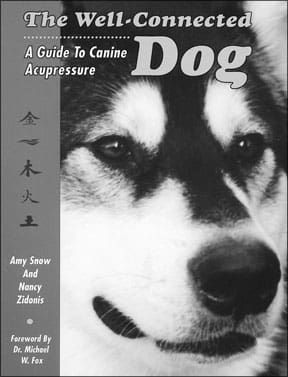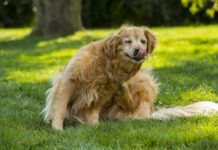When spring is in the air, every dog knows it. Spring is the season when dogs want to run, play, and stretch their bodies, when their eyes brighten, and their natural zest for life flows through their veins. Spring is a time of action.
There are so many canine performance sports today that require peak levels of running, twisting, turning, jumping, and pivoting. Anyone watching a canine agility trial or flyball competition can see the adrenaline pumping through every ounce of the dog’s being. Adrenaline can override the senses and the animal can unknowingly hurt himself badly, especially early in the season.
The risk of injury is very high when a dog is not properly conditioned. Also, dogs need to be given the opportunity to warm up before engaging in the burst of excitement and energy they experience at the moment they are released for coursing, a herding test, or on a sledding trail.
Physical conditioning takes time and different parts of the body condition at different rates. Muscles are first to build. Cardiovascular conditioning occurs next. This is followed by the strengthening of tendons, and then ligaments, which hold the joints securely.
All conditioning regimes need to be designed for each specific dog and his particular sport. Training programs for a dog will depend on his age, breed, weight, and current general fitness level.
Canine Exercise
Physiologists usually recommend that a dog begin conditioning by successive short runs in a straight line; that is, run 50 to 100 yards, stop, walk, run another 50 to 100 yards, and so on. By traveling in a straight line on a surface with good traction, the dog’s muscles and tendons are allowed to strengthen while not being overly stressed.
The next step in conditioning is to progress toward running on uneven terrain with incrementally increased amounts of turning and pivoting to build well-rounded muscles and strong, flexible tendons and ligaments.

Exercise experts advise dog owners to make sure their dogs warm up before (and cool down after) strenuous exercise. Remember to make water available for the dog before and after activity.
Watch for fatigue and any indication of pain. A dog will naturally shift his body weight or alter his gait to compensate for tired muscles or pain, thus compromising other parts of his body. Injuries tend to occur when the body is off-balance, even slightly. Also, veterinary sports medicine practitioners report that the most common canine orthopedic injuries are repetitive stress injuries caused when the dog is tired but naturally driven to continue.
Enhance Conditioning with Acupressure
The ancient healing art of acupressure offers a method of enhancing the conditioning process. Acupressure, which is based on Traditional Chinese Medicine, is known to:
-
Build flexibility of tendons and ligaments
-
Decrease inflammation of soft tissues and joints
-
Strengthen and warm muscles by supplying necessary nutrients
-
Relieve muscle spasms by establishing a smooth flow of energy and blood
-
Remove toxins from an injured area while replenishing with healthy cells, and
-
Reduce the painful build-up of lactic acid in the muscles by increasing blood circulation.
Acupressure Session

On the dog’s body there are specific acupressure points, or little energetic pools, where we can access and thus influence the flow of energy, in this case, to optimize the dog’s conditioning program. The following acupressure points, also called “acupoints,” can be used while building toward peak performance.
-
Bladder 17 (also known as “Diaphragm Transporting.”) Bl 17 is a powerful acupoint that enhances the flow of blood throughout the body. Cardiovascular health is the key to all the biomechanical functions of the body. Good blood and energy circulation ensures that all the tissues receive nourishment, so that healthy cells can form while lactic acid and toxic substances are removed. It is the continuous flow of replenishment and removal that makes for the strengthening and building of muscles, tendons, and ligaments.
-
Gall Bladder 34 (“Yang Hill Spring.”) GB 34 is used facilitate the flexibility of tendons and ligaments. Tendons and ligaments are like the new, young branches on a tree; when the wind blows, they must be flexible and bend, or they will snap and break. Maximizing the flexibility and strength of ligaments helps increase the flexibility and weight-bearing capacity of the joints.
-
Spleen 6 (“Three Yin Meeting.”) SP 6 is often used to nourish the muscles and other soft tissues of the forelimbs and especially the hindquarters. Good muscle tone is dependent on nutrient-rich blood. SP 6 is known for its ability to enhance the circulation and nourishment of the blood.
-
Stomach 36 (“Leg Three Mile.”) As the “master point” for the gastrointestinal system, ST 36 is very important in converting food substances into refined, bioabsorbable nutrients to be circulated in the blood. ST 36 is known for its ability to contribute to a dog’s overall physical endurance because it promotes energy throughout the body.
Between receiving a spring maintenance acupressure session every five to six days and careful physical conditioning, the canine athlete will have a good time getting back into action this spring.
Acupoint Technique
Settle down in a quiet, comfortable space with your dog for an acupressure session, always keeping two hands on his body. Rest the soft tip of your thumb on an acupoint and exert about one pound of pressure (less for smaller dogs). Place your other hand comfortably on another portion of the dog’s body. On smaller dogs it may be more comfortable to use your index finger with your middle finger on top of it for the point work instead of your thumb.
Keep your thumb, or index and middle finger, on the acupoint for at least the count of 30. If your dog shows any signs of distress or pain while holding the point, stop and try it again some other time.
All of the acupoints are located on both sides of the dog’s body. Once you complete the series on one side, ask the dog to turn or roll over and work on the same acupoints on the other side.

You will know you are doing a good job when your dog indicates he is experiencing energy moving more smoothly through his body. Dogs express the movement and harmonious flow of energy by yawning, stretching, passing air, rolling over, licking in general or licking your hand on the point, or sometimes just breathing more deeply and falling asleep.
Amy Snow and Nancy Zidonis are the authors of The Well-Connected Dog: A Guide to Canine Acupressure, Acu-Cat: A Guide to Feline Acupressure, and Equine Acupressure: A Working Manual. They founded Tallgrass Animal Acupressure Institute, which offers a practitioner certificate program and training programs worldwide, plus books, meridian charts, and videos.






